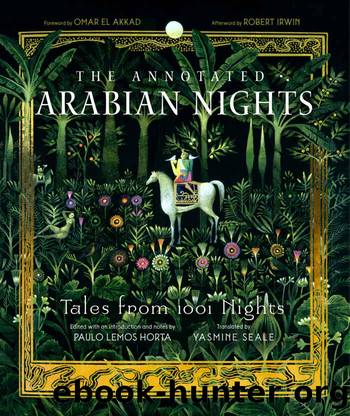The Annotated Arabian Nights: Tales from 1001 Nights by Paulo Lemos Horta

Author:Paulo Lemos Horta
Language: eng
Format: azw3, epub
Publisher: Liveright
Published: 2021-11-16T00:00:00+00:00
PRINCE AHMAD AND THE FAIRY PARI BANU
The tale that gifted readers with the image of the flying carpet, âPrince Ahmad and the Fairy Pari Banu,â has become one of the most influential stories of the Arabian Nights. It is the archetypal fairy tale in many respects, and not just because its female protagonist is literally a fairy, or, as she is called in the story, a Persian âperi.â After witnessing a quest for magic objects in exotic locations, the reader is ushered into an amazing fairy kingdom, filled with enormous wealth, to witness a series of trials meant to test the worth of a young prince.
The quest for marvelous objects that serves as the opening of âPrince Ahmadâ is one of the most common plots in narrative culture, and its presence in several European folktales has led some critics to stress a European influence on this tale. The ubiquity of this story pattern in folklore, however, may be the result of the influence of the French tale, told by the Syrian storyteller Hanna Diyab to Antoine Galland1 in 1708 and added to the last volume of his translation of the Arabian Nights in 1717. Narrative historian Ulrich Marzolph has tracked numerous versions of the tale that he believes entered oral narrative culture throughout Europe after Gallandâs tale to produce a wide range of retellings, including one in Icelandic (101 Middle Eastern Tales, pp. 105â9).
The tale comprises two essential narratives. In the first part, three princes compete for the hand of the same woman by setting out into the world to secure the most extraordinary object they can find. This opening narrative mixes the pleasures of foreign lands and busy marketplaces with the sheer enchantment of a magic flying carpet, a remarkable telescope, and an apple with miraculous healing powers. The roots of this story can be found in an eleventh-century Indian story cycle and its Persian adaptation, well before such plots became a feature of the French fairy tales of Marie-Catherine dâAulnoy, who also sends three princes on a quest before the youngest marries a beautiful woman with magic powers.
When Prince Ahmad loses his bid to win the bride in the opening adventure, he is drawn into the fairy-tale world of Pari Banu, and the tale becomes a love story in which the hero must prove himself worthy of his powerful bride while also navigating the vicious politics of his home court. In this endeavor, Pari Banu demonstrates her intelligence and rich store of magic and proves herself to be one of the most powerful female characters in the tales of the Arabian Nights. The quest of the three princes for a marvelous object provided the plot for Douglas Fairbanksâs The Thief of Bagdad (1924), but it is Pari Banuâs gracious presence that highlights the Prince Ahmad plot borrowed by Lotte Reiniger for her groundbreaking animated film of 1926, The Adventures of Prince Achmed. Through these seminal adaptations, the story of Ahmad and Pari Banu has gone on to influence
Download
The Annotated Arabian Nights: Tales from 1001 Nights by Paulo Lemos Horta.epub
This site does not store any files on its server. We only index and link to content provided by other sites. Please contact the content providers to delete copyright contents if any and email us, we'll remove relevant links or contents immediately.
| Fairy Tales | Folklore |
| Mythology |
Circe by Madeline Miller(8007)
Confessions of an Ugly Stepsister by Gregory Maguire(7830)
A Court of Wings and Ruin by Sarah J. Maas(7650)
Burn for You (Slow Burn Book 1) by J.T. Geissinger(7028)
The Bird and the Sword by Amy Harmon(5193)
A Lesson in Thorns (Thornchapel Book 1) by Sierra Simone(5035)
Into the Drowning Deep by Mira Grant(4414)
Stolen (Alpha's Control Book 1) by Addison Cain(4143)
The Queen and the Cure (The Bird and the Sword Chronicles Book 2) by Amy Harmon(3975)
Mythology by Edith Hamilton(3714)
Pernicious Red (When The Wicked Play Book 1) by Natalie Bennett(3479)
Run Little Wolf (The Forest Pack Series Book 1) by G. Bailey(3458)
The Queen and the Cure by Amy Harmon(3190)
(Maiden Lane #5) Lord of Darkness by Elizabeth Hoyt(3017)
Lost Boy by Christina Henry(2974)
Mythos by Stephen Fry(2806)
The Fairy Queen (The Dark Queens Book 6) by Jovee Winters(2769)
Persephone by Kitty Thomas(2652)
Bunny by Mona Awad(2356)
